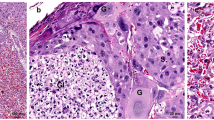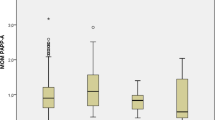Abstract
Neosporosis is the major cause of abortion and reproductive failures in cattle, leading to significant economic losses. In this study, we evaluated the impact of Neospora caninum infection on oxidative stress (OS) markers and local cytokine mRNA expression at the placenta, as well as its effect on the progesterone (P4) serum levels and systemic cytokine profile in a pregnant mouse model. Infected pregnant mice (NC-1 group) showed increased percentages of fetal losses and IFN-γ serum levels, decreased serum progesterone, increased placental mRNA expression levels of both Th1-type (IFN-γ and TNF-α) and Th2-type (IL-4) cytokines, and inhibited expression of TGF-β1 (Treg) compare to control dams (CONTROL group). In addition, lipid peroxidation and ROS were increased, whereas the antioxidant enzymes, superoxide dismutase (SOD), and catalase (CAT) activities were modified in the placentae of infected mice compared to control mice. These findings demonstrate that multiple factors, including placental OS, are involved in fetal losses associated with N. caninum infection in mice, thus OS contribution to the placental physiopathology of neosporosis in other hosts must not be ruled out.


Similar content being viewed by others
Data availability
All data used are represented in the manuscript and are available to any researcher who wishes to use them for non-commercial purposes.
References
Arck P, Hansen PJ, Mulac Jericevic B, Piccinni MP, Szekeres-Bartho J (2007) Progesterone during pregnancy: endocrine-immune cross talk in mammalian species and the role of stress. Am J Reprod Immunol 58(3):268–279. https://doi.org/10.1111/j.1600-0897.2007.00512.x
Bengoa-Luoni SA, Corigliano MG, Sánchez-López E, Albarracín RM, Legarralde A, Ganuza A, Clemente M, Sander VA (2019) The potential of a DIVA-like recombinant vaccine composed by rNcSAG1 and rAtHsp81.2 against vertical transmission in a mouse model of congenital neosporosis. Acta Trop 198:105094. https://doi.org/10.1016/j.actatropica.2019.105094
Biri A, Kavutcu M, Bozkurt N, Devrim E, Nurlu N, Durak I (2006) Investigation of free radical scavenging enzyme activities and lipid peroxidation in human placental tissues with miscarriage. J Soc Gynecol Investig 13(5):384–388. https://doi.org/10.1016/j.jsgi.2006.04.003
Clark DA, Chaouat G (1986) Characterization of the cellular basis for the inhibition of cytolytic effector cells by murine placenta. Cell Immunol 102(1):43–51. https://doi.org/10.1016/0008-8749(86)90324-2
da Silva MV, Ferreira França FB, Mota CM, de Macedo JAG, Ramos EL, Santiago FM, Mineo JR, Mineo TW (2017) Dectin-1 compromises innate responses and host resistance against Neospora caninum infection. Front Immunol 8:245. https://doi.org/10.3389/fimmu.2017.00245
da Silva AS, Gebert RR, Reis JH, Baldissera MD, Souza CF, Barros LD, Garcia JL, Gris A, Mendes RE (2020) Experimental infection by Neospora caninum in gerbil reduces activity of enzymes involved in energy metabolism. Exp Parasitol 208:107790. https://doi.org/10.1016/j.exppara.2019.107790
Entrican G (2002) Immune regulation during pregnancy and host-pathogen interactions in infectious abortion. J Comp Pathol 126(79–94):6. https://doi.org/10.1053/jcpa.2001.0539
García-García JA, Reding-Bernal A, López-Alvarenga JC (2013) Cálculo del tamaño de la muestra en investigación en educación médica. Investig Educ Méd 2(8):217–224. https://doi.org/10.1016/S2007-5057(13)72715-7
Glombowsky P, Bottari NB, Klauck V, Fávero JF, Soldá NM, Baldissera MD, Perin G, Morsch VM, Schetinger MRC, Stefani LM, Da Silva AS (2017) Oxidative stress in dairy cows seropositives for Neospora caninum. Comp Immunol Microbiol Infect Dis 54:34–37. https://doi.org/10.1016/j.cimid.2017.07.007
Horcajo P, Regidor-Cerrillo J, Aguado-Martınez A, Hemphill A, Ortega-Mora LM (2016) Vaccines for bovine neosporosis: current status and key aspects for development. Parasite Immunol 38:709e723. https://doi.org/10.1111/pim.12342
Innes EA (2007) The host-parasite relationship in pregnant cattle infected with Neospora caninum. Parasitology 134:1903–1910. https://doi.org/10.1017/S0031182007000194
Jia L, Xie S, Li J, Li H, Wang H, Zhao S, Zhang S (2020) Establishment of a model of Neospora caninum infection in pregnant mice. Parasitol Res 119(11):3829–3837. https://doi.org/10.1007/s00436-020-06903-0
Jiménez-Pelayo L, García-Sánchez M, Regidor-Cerrillo J, Horcajo P, Collantes-Fernández E, Gómez-Bautista M, Hambruch N, Pfarrer C, Ortega-Mora LM (2019) Immune response profile of caruncular and trophoblast cell lines infected by high- (Nc-Spain7) and low-virulence (Nc-Spain1H) isolates of Neospora caninum. Parasit Vectors 12(1):218. https://doi.org/10.1186/s13071-019-3466-z
Lautraite S, Bigot-Lasserre D, Bars R, Carmichael N (2003) Optimisation of cell-based assays for medium throughput screening of oxidative stress. Toxicol InVitro 17(2):207–220. https://doi.org/10.1016/s0887-2333(03)00005-5
López-Pérez IC, Collantes-Fernández E, Aguado-Martínez A, Rodríguez-Bertos A, Ortega-Mora LM (2008) Influence of Neospora caninum infection in BALB/c mice during pregnancy in post-natal development. Vet Parasitol 155(3–4):175–183. https://doi.org/10.1016/j.vetpar.2008.05.018
López-Pérez IC, Collantes-Fernández E, Rojo-Montejo S, Navarro-Lozano V, Risco-Castillo V, Pérez-Pérez V, Pereira-Bueno J, Ortega-Mora LM (2010) Effects of Neospora caninum infection at mid-gestation on placenta in a pregnant mouse model. J Parasitol 96(5):1017–1020. https://doi.org/10.1645/GE-2347.1
Moriconi JI, Buet A, Simontacchi M, Santa-María GE (2012) Near-isogenic wheat lines carrying altered function alleles of the Rht-1 genes exhibit differential responses to potassium deprivation. Plant Sci 185–186:199–207. https://doi.org/10.1016/j.plantsci.2011.10.011
Mota CM, Lima-Junior DS, Ferreira França FB, Aguillón Torres JD, Barros PDSC, Santiago FM, Silva JS, Mineo JR, Zamboni DS, Mineo TWP (2020) Interplay between reactive oxygen species and the inflammasome are crucial for restriction of Neospora caninum replication. Front Cell Infect Microbiol 10:243. https://doi.org/10.3389/fcimb.2020.00243
Quinn HE, Ellis JT, Smith NC (2002) Neospora caninum: a cause of immunemediated failure of pregnancy? Trends Parasitol 18:391–394. https://doi.org/10.1016/s1471-4922(02)02324-3
Rosbottom A, Gibney H, Kaiser P, Hartley C, Smith RF, Robinson R, Kipar A, Williams DJ (2011) Upregulation of the maternal immune response in the placenta of cattle naturally infected with Neospora caninum. PLoS One 6(1):e15799. https://doi.org/10.1371/journal.pone.0015799
Sander VA, Piehl L, Facorro GB, Rubín de Celis E, Motta AB (2008) Regulation of functional and regressing stages of corpus luteum development in mice. Role of reactive oxygen species. Reprod Fertil Dev 20(7):760–9. https://doi.org/10.1071/rd08051
Sinha K, Das J, Pal PB, Sil PC (2013) Oxidative stress: the mitochondria-dependent and mitochondria-independent pathways of apoptosis. Arch Toxicol 87(7):1157–1180. https://doi.org/10.1007/s00204-013-1034-4
Solano ME, Thiele K, Kowal MK, Arck PC (2016) Identification of suitable reference genes in the mouse placenta. Placenta 39:7–15. https://doi.org/10.1016/j.placenta.2015.12.017
Souza JS, Farani PSG, Ferreira BIS, Barbosa HS, Menna-Barreto RFS, Moreira OC, Mariante RM (2023) Establishment of a murine model of congenital toxoplasmosis and validation of a qPCR assay to assess the parasite load in maternal and fetal tissues. Front Microbiol 14:1124378. https://doi.org/10.3389/fmicb.2023.1124378
Tang Z, Li H, Xie S, Zhao S, Zhang S, Wang H, Li N, Zhang X, Zhao F, Jia L (2023) A preliminary study on placental damage associated to experimental neosporosis in BALB/c mice. Parasitol Res 122(3):781–788. https://doi.org/10.1007/s00436-022-07771-6
Tao DL, Zhao SS, Chen JM, Chen X, Yang X, Song JK, Liu Q, Zhao GH (2022) Neospora caninum infection induced mitochondrial dysfunction in caprine endometrial epithelial cells via downregulating SIRT1. Parasit Vectors 15(1):274. https://doi.org/10.1186/s13071-022-05406-4
Tonin AA, da Silva AS, Thomé GR, Bochi GV, Schetinger MR, Moresco RN, Camillo G, Toscan G, Vogel FF, Lopes ST (2014) Oxidative stress in brain tissue of gerbils experimentally infected with Neospora caninum. J Parasitol 100(1):154–156. https://doi.org/10.1645/13-310.1
Wu F, Tian FJ, Lin Y, Xu WM (2016) Oxidative stress: placenta function and dysfunction. Am J Reprod Immunol 76(4):258–271. https://doi.org/10.1111/aji.12454
Funding
This work was supported by grants to Dr. Valeria A. Sander (PICT 2016–0310) and Dr. Marina Clemente (PICT 2016–0621) from Agencia Nacional de Promoción Científica y Tecnológica (Argentina). The study also received institutional support from the Universidad Nacional General de San Martín (UNSAM, Argentina).
Author information
Authors and Affiliations
Contributions
LFMM and VL contributed to the conception and design of the study, performed the experiments, and analyzed the data. MGC, ESL, and VAR performed part of the experiments. AL and AG maintain the mice and the parasite cultures, respectively. MC contributed with writing—review, editing, and funding acquisition, and VS participated in conceptualization, visualization, supervision, project administration, funding acquisition, and writing—review of the MS.
Corresponding author
Ethics declarations
Ethics approval and consent to participate
All procedures requiring animals were performed in agreement with institutional guidelines and were approved by the Independent Ethics Committee for the Care and Use of Experimental Animals of National University of General San Martin (C.I.C.U.A.E., IIB-UNSAM).
Consent for publication
Not applicable.
Competing interests
The authors declare no competing interests.
Additional information
Section Editor: Daniel Howe
Publisher's Note
Springer Nature remains neutral with regard to jurisdictional claims in published maps and institutional affiliations.
Supplementary Information
Below is the link to the electronic supplementary material.
Rights and permissions
Springer Nature or its licensor (e.g. a society or other partner) holds exclusive rights to this article under a publishing agreement with the author(s) or other rightsholder(s); author self-archiving of the accepted manuscript version of this article is solely governed by the terms of such publishing agreement and applicable law.
About this article
Cite this article
Morales, L.F.M., Lagorio, V., Corigliano, M.G. et al. Dysfunction, oxidative stress markers, and cytokine expression in the placentae of mice experimentally infected with Neospora caninum. Parasitol Res 122, 3257–3263 (2023). https://doi.org/10.1007/s00436-023-07995-0
Received:
Accepted:
Published:
Issue Date:
DOI: https://doi.org/10.1007/s00436-023-07995-0




